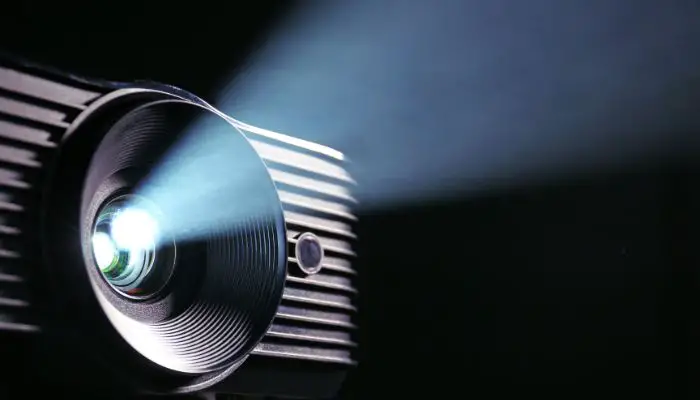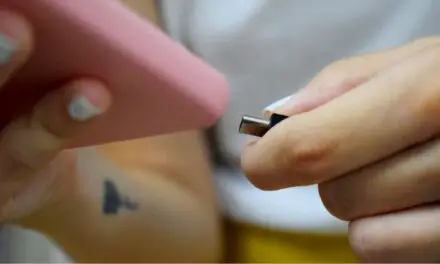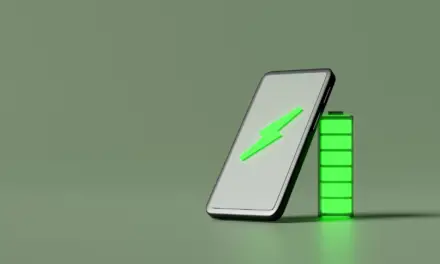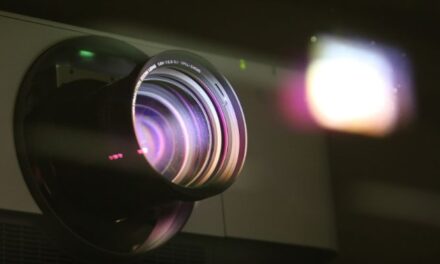It used to be the case that projectors were more for business conferences or safety training videos, at least outside of the theater. Anything else was a major investment in home entertainment for those who had the space and the money for a home theater.
Now, projectors are far more mainstream, with high-quality projectors arriving in very small packages—small enough to attach to a smartphone for some portable enjoyment. Some don’t connect to your phone at all but link to it via Bluetooth.
But like with every other piece of tech that goes viral and captures our imaginations, brands inevitably try to make a quick buck and promise more than these devices can deliver.
So are all smartphone projectors overhyped or are there some good options available?
Table of Contents
Are Smartphone Projectors Any Good?

You’re not going to get theater-level quality out of most smartphone projectors, nor will you even get 4k resolution out of most, but smartphone projectors are definitely good. It’s just a matter of picking solid brands with solid reputations.
We’re talking about your household name brands here, such as Sony, LG, Anker, Kodak, Epson, and Optoma. Then there are some of the lesser known but not lesser quality brands, such as AuKing, AAXA, RAGU, and RIF6.
But besides that, there are hundreds of brands looking to cash in on the fantasy that your smartphone can project a large OLED-beating image on your bedroom wall, which obviously it can’t, at least, not yet.
You can buy a $20 cardboard smartphone projector that will put out a dim, grainy image in a pitch black room or you can buy a $1,000 smartphone-compatible, mini laser projector that will project an ultra HD image on your wall with 1,000 lumens.
There are also hundreds of smartphone projectors that match budgets within and beyond this price range.
With the cheapest models, you’re going to be buying a novelty device and not something practical that you’ll enjoy using regularly. It will be more like something you’d show off to the kids once or twice.
You’ll find that you get what you pay for and many of these cheap, generic smartphone projectors will present you with inaccurate specs, like swapping lux for lumens to deceive you on the brightness of the device. With the cheapest of projectors, it’s often brightness and the ability to focus that are compromised and these are two of the most important things for an enjoyable experience.
To negate these issues, try to at least buy from a recognizable brand.
There are ‘mini-projectors’ and portable projectors—both of which connect to your smartphone—it just depends on what you want and the kind of resolution and technology you expect to get out of it.
If you jump on an online retail site like Amazon, you will come across so many brands that it’s difficult to parse the good from the bad. In fact, most online electronics retailers are going to offer a large variety of portable projectors for use with a smartphone.
The sad fact is, that a lot of people opt for cheap mini-projectors that fail before too long or are very sub-par. It makes for a mixed bag of customer reviews with a lot of smartphone projectors and when you look at it from a zoomed-out perspective, the overall result is ‘meh’.
What Does A Smartphone Projector Do?
A smartphone projector is essentially a smartphone screen-shared device. The only difference is, that you’re sharing your phone screen as a projection on a wall or a projector screen. It’s a very simple concept and it’s very simple in practice as well.
In fact, you can design your own smartphone projector with a shoebox, mirror, magnifying glass, and some glue. For the most part, smartphone projectors simply connect to your smartphone through Bluetooth and project your screen.
Other smartphone projectors, like the Smartphone Projector 2.0, simply magnify your smartphone’s screen and project it onto a wall or physical screen with a light and a lens. These kinds of smartphone projectors are very low-tech using materials you can easily acquire and assemble at home.
While the second option may seem like a good science fair project at home, you are depending on the brightness of your phone only, so don’t expect to get a very good projection on the wall unless your room is pitch black and your smartphone is high-end.
For the most part, you will have to download an app associated with the projector that you purchase. The projector will connect to your smartphone with a cable or through Bluetooth and you will run everything through the app or through various streaming services such as Chromecast or Miracast.
For premium mini-projectors, you can purchase an HDMI adaptor or use one of the newer MHL wired projects to get the maximum resolution out of your projector.
What Are The Best Options For Turning My Smartphone Into A Projector?
Your best option for turning your smartphone into a projector is to purchase a mini projector or a projector that is designed for smartphone use. If you are referring to specifically turning your smartphone into a projector, most smartphones don’t have that capability, though there are a few. The Epson EpiqVision Mini EF12 and the KODAK Luma 350 Portable Smart Projector are solid options. And if you wanted to buy a novelty smartphone with a decent projector built-in, The Blackview MAX 1 is probably your best bet.
A typical smartphone cannot project its picture, it can only cast it, as in wirelessly transferring the video and audio information to an external projector device, the latter of which does the rest of the work of projecting your smartphone’s screen on the wall.
You can build or buy a device that technically turns your smartphone into a projector. However, all this device does is magnify your phone’s touchscreen, using the brightness that your smartphone provides to project an image onto a wall or screen.
Even smartphones that have really bright screens can only provide enough lumens for a very close-up wall screen. The farther back you pull the device, the lower the resolution and brightness displayed on the wall/screen.
How Do I Use My Phone As A Projector?
There are a few ways that you can do this, depending on what you’re buying, building, and what kind of smartphone you have.
- HDMI Adaptor connection to a mini or portable projector
- MHL connection to a mini or portable projector
- Build your own smartphone projector
- Purchase a shoebox smartphone projector
- Wirelessly connect to a mini or portable smartphone projector (Bluetooth or WiFi)
- Cast to a projector of any kind that is compatible with your smartphone or smartphone app
- Purchase a smartphone with a lens to project video
Purchasing a projector that is designed for portability and smartphone connectivity is kind of self-explanatory. There are a ton of portable and mini-projectors out there and they all have their own apps, even though some of them will support streaming apps on your smartphone.
Building your own can be a fun project, though you will never get the level of resolution and wow factor that you will get from a portable projector. The only other way to turn your Smartphone into a projector is to build one, such as the shoebox project in this YouTube Video.
Related Article: Can A Projector Work In Daylight? (And How To Get The Best Picture)
Can I Project An Image From My Phone?
Unless you have a specialized smartphone like one of the ones mentioned above, smartphones aren’t designed with built-in hardware to project images or video. You can also make your own shoebox smartphone projector using a few common items.
For the most part, if you want a “smartphone projector,” you will have to buy a separate projector device and connect your smartphone to it. There are a lot of Tik Tok and Facebook videos floating around out there that insinuate you can use your smartphone’s flashlight to project video or even 3-D imagery.
These claims are false. The flashlight is a single source of illumination, no more sophisticated than an LED flashlight you may have in the kitchen drawer in case of power outages.
Are There Smartphones With Built-In Projectors?
There are a few smartphones on the market that actually have projector capability, with their own built-in lenses and enough lumens to get the job done in a fairly dark room (around 30-35 lumens).
The Blackview MAX 1 Is one of the newer and probably one of the better options for smartphones with built-in projectors. This phone has a projection lens built into the top and a projection button to instantly project whatever is on your screen. Facing a wall in a dark room, the Blackview MAX 1 will put out a pretty decent-looking image that’s 20 to 50 inches in size (depending on how close the phone is to the wall).
These other projector smartphones aren’t all that easy to find either. You’re not likely to run into them at your local Verizon, T-Mobile, or AT;T retailer. The MOVI uses a Snapdragon 821 processor and 4GB of RAM, which is kind of yesterday’s news.
Lenovo, a company associated with computers, gave it a go in the smartphone arena with the Lenovo Smartcast. But that was back in 2015-2016 and it never really hit the mainstream.
The Voga 2 has a MEMS-based projector built into the top/center of the smartphone. It was introduced in 2020 but since no one has really heard of it, you can guess where that went.
The Akyumen Holofone came out back when Windows phones were a thing. When Windows phones failed, so did the Holofone, though you can probably find one out there on eBay. Last but not least, the Samsung Galaxy Beam was discontinued in 2014.
Are Smartphone Projector Apps Useful?
Most portable or mini projectors have an associated app because they are designed to function with tablets and smartphones. Those apps make a world of a difference when it comes to operating the projector with your smartphone.
All of the major brand projectors, such as Sony, Epson, Optoma, LG, etc, all have apps that you can download on your smartphone, making connecting and playing movies, home videos, or just projecting pictures on a screen or on the wall simple.
There are plenty of guides out there with “best projector apps for Android” or “best projector apps for iOS” articles galore. Some of the available apps are universal. They will operate with just about any kind of projector you decide to purchase.
No matter what mini-projector you purchase, you will need an app of some sort to operate your smartphone with it.
Can My Phone’s Flashlight Be Used As A Projector?
Your smartphone’s built-in flashlight lumens are anywhere between 30 and 50 lumens. But that’s all it is—a semi-bright flashlight to use when you lose your keys under the couch. You can’t project movies from a smartphone flashlight.
Now, if you had some film and a device that could run film across the light while containing and focusing the LED, you would get a sort of decent moving video splashed out across your wall. But that’s about the extent of it.
It’s even more important that you recognize that some of these sites that claim you can use your flashlight as a projector are scams and they are attempting to get you to download a malicious app or visit websites that are malicious.
Can A Smartphone Projector Be Used Outdoors?
Any projector that you connect to a smartphone can potentially be used outside. The only thing you need to be concerned about is lumens. A projector outside, in the middle of the day, is probably not going to work out well.
At night, however, so long as the moon is not exceptionally bright and shining right down on top of you, a solid smartphone/mini projector could work okay.
You want something with a lot of lumens. Outside during the daytime, you need shade and a lot of lumens to take full advantage of the resolution.
If you’ve picked up a cardboard smartphone projector for $20, you’re not going to have much luck outside, unless you go into a pitch-black shed. On the other hand, if you spend a few hundred on a mini projector and have way more lumens to play with, you will have a much better experience.
The Kodak Luma 150 Ultra Mini Pocket Pico Projector is an excellent portable/mini projector that works great with iOS and Android devices and it’s just one example. Unfortunately, mini/portable projectors simply don’t have the lumens to overcome sunlight hours.
Since most of your smartphone projectors are mini projectors, you can play with them and enjoy them outdoors when it’s nighttime. Although larger and more expensive projectors aren’t considered to be “smartphone” projectors, you can certainly cast to them or plug your smartphone into them as well.



